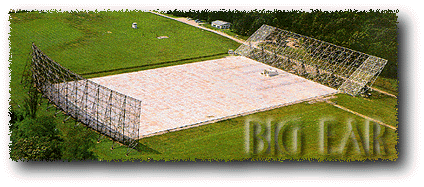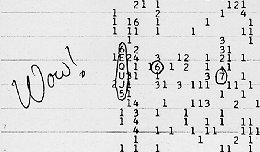SETI 的历史 - 10
<资料来源:The Planetary Society>
第10章:“哇!”
The longest running as well as one of the most famous searches was conducted with the use of the giant "Big Ear" radio telescope at Ohio State University. "Big Ear" was no ordinary radio-telescope: instead of the familiar "dish," it was composed of a flat aluminum surface the size of three football fields, with a giant reflector at each end - one flat and one parabolic. Its sensitivity was equivalent to that of a 175-foot dish. From 1973 up to its dismantling in 1998 (to make room for a golf course), its most important mission was a continuous dedicated hydrogen-line SETI search.
The most famous moment in the history of Big Ear, which earned it a place of honor in the annals of SETI, came on the night of August 15, 1977. As on every other night, as Big Ear was searching the skies for an alien signal, its observations were being recorded on a printout sheet: a long list of letters and numbers was continuously being churned out, one long list for every one of the fifty channels scanned by the telescope. A list of characters appeared recording an unusual transmission at the frequency of channel 2: "6EQUJ5" the list read. This startled Big Ear volunteer Jerry Ehman, a professor at Franklin University in Columbus, who was monitoring the readings that night. He circled the code for later reference and added a single comment in the margins" "Wow!"
This was, of course, the famous "Wow!" signal, which immediately entered SETI lore. The series "6EQUJ5" described the strength of the received signal over a short time-span. In the system used at the time at Big Ear, each number from 1 to 9 represented the signal level above the background noise. In order to extend the scale, the staff added letters, with each one from A to Z representing increasingly stronger signal levels. 6EQUJ5 represented a signal that grew in strength to level "U," and then gradually subsides. In more familiar notation, the signal increased from zero to level 30 "sigmas" above the background noise, and then decreased again to zero, all in the span of 37 seconds.
Two aspects of this signal immediately caught the attention of Ehman and project director John Kraus, who saw the results the following morning. First of all, 37 seconds was precisely the time it takes the Big Ear scanning beam to survey a given point in the heavens. Because of this, any signal coming from space would follow precisely the "Wow!" signal's pattern - increasing and then decreasing over 37 seconds. This practically ruled out the possibility that the signal was the result of Earthly radio interference.
Secondly, the signal was not continuous, but intermittent. Kraus and Ehman knew that, because Big Ear has two separate beams that scan the same area of the sky in succession, several minutes apart. But the signal appeared on only on of the beams and not on the other, indicating that it had been "turned off" between the two scans. A strong, focused and intermittent signal coming from outer space: Could it be that Big Ear had detected an alien signal?
Since 1977 several attempts had been made to find the "Wow!" signal once more - to no avail. To this day we do not know the source of the strongest and clearest signal ever to come through on a SETI search. Since it was undoubtedly artificial, and almost certainly of celestial origin, Jerry Kraus speculates that it may have come from a space probe (human space probe, that is…) that he and the Big Ear staff were not aware of. That would certainly make it an intelligent celestial signal, but not an alien one. And still, there is always the possibility that it was something else - a true signal from an alien civilization. Unless the signal is detected again, we may never know for sure.
第9章:Opza - 一个怀疑论者的搜索 ← | → 第11章:美国航太总署的介入

